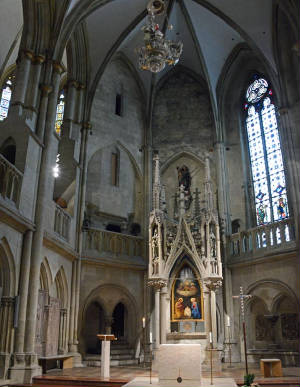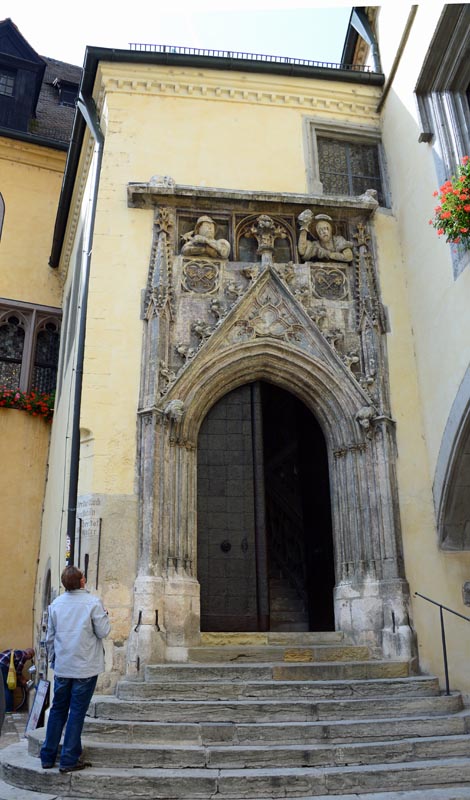Our first stop in Regensburg was the Gothic Cathedral of St. Peter.
Its’ twin Renaissance towers are some of the nicest in Bavaria.






Note the modern day “catwalk” between the two towers. Reminds me of the Petronas Twin Towers in Kuala Lumpur. Your friendly Skunk worked on those buildings for a while.



Most buildings in Europe are constructed of sandstone or limestone or occasionally brick. The building material was generally determined by what was available locally. All of these materials have pores surfaces. Until recently coal was the primary heating fuel in Europe. Coal equals air pollution. Air pollution penetrates the pores surface of the builds, causing them to turn black. Here is an example of before and after cleaning of this cathedral’s outer surface.



The cathedral well with a baptismal fount conveniently located nearby.


The Erminold Maria is one element of an Annunciation group in the Regensburg Cathedral. It goes back to the so-called Erminoldmeister, who carved and colorfully painted the figure of Mary and the famous laughing figure of Gabriel, the Angel of Annunciation about 1280. The figures are facing each other on the two western pillars at the crossing of the nave. Mary’s right hand is slightly raised toward the angel in greeting. In her left hand she holds a book, into which she is pointing with her index finger.



This alter is made from silver with gold overlays.



The rich tones of the stained glass windows are difficult to capture in the photo.

We then headed for the Old Town Hall “Altes Rathaus” and passed some interesting site on the way.

Oskar Schindler (28 April 1908 – 9 October 1974) was an ethnic German industrialist, German spy, and member of the Nazi Party who is credited with saving the lives of 1,200 Jews during the Holocaust by employing them in his enamelware and ammunitions factories, which were located in occupied Poland and the Czech Republic. After the war, Schindler and his wife Emilie settled in Regensburg, Germany, until 1950, when they immigrated to Argentina. They lived in this house during their time in Regensburg


The ‘Goliath House’ (Goliathhaus), built in 1260, is considered one of the most well-known landmarks of Regensburg with its painting of David and Goliath done in 1573. The name is likely not derived from the biblical epic, but rather from the name ‘Goliards’. Theology students were called Goliards as their guardian angel was called Golias but yet the mural of the Biblical David and Goliath appears on its walls. Go Figure!


The Old Town Hall







The pidgin is an optional accessory that may take flight at any moment.

Scots Church of St. Jacob.


A building that used old Jewish Tombstones as part of the construction material. Why was Europe so ant-Jewish? Jewish persecution can be found as far back as ancient Egypt. There are many theories but I was unable to find any real reasons. One was that the Pope in the fourth century outlawed lending money with interest attached. As Jews were not bound by the decree. they became the “bankers” with Christians becoming the debtors. What better way to get out of debit than by killing off the bankers? You can find an extensive article concerning anti-Semitism at:
http://en.wikipedia.org/wiki/Antisemitism 










In the US we would build a massive barrier to keep people from driving off the end of a pier. In Europe they believe people are intelligent enough to be warned by an sign. If they drive off the end, they are charged to recover the car. No lawsuits be cause they were stupid enough to do it in the first place.

Back on the boat for a great buffet lunch. Breakfast and lunch were served buffet style or you could also order from the menu and be served at your table. Depended in how much of a hurry you were in. Dinner was always off the menu with a couple of exceptions.

